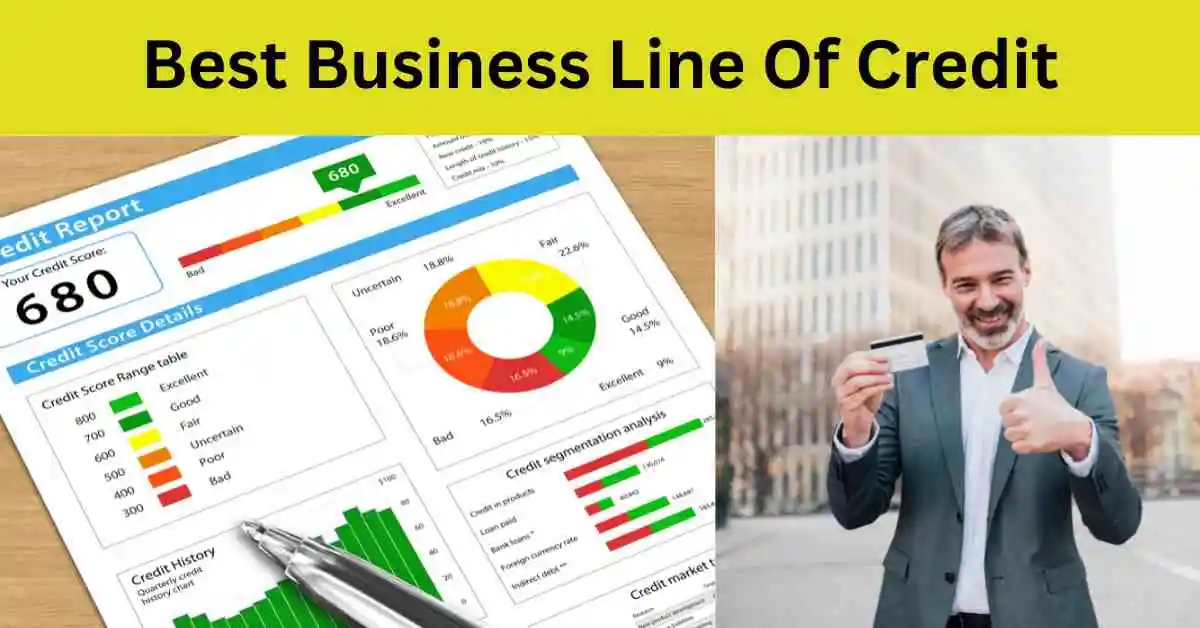
what is the best business line of credit
A business line of credit is a loan that allows a business to borrow money up to a certain credit limit, which can be used as needed. The best business line of credit for a particular business will depend on its specific financial needs and goals. Some factors to consider when looking for a business line of credit include the interest rate, fees, repayment terms, and credit limit.
Here are a few things to consider when evaluating business lines of credit:
- Interest rate: A lower interest rate can save you money on the cost of borrowing. Be sure to compare rates from multiple lenders to find the best deal.
- Fees: Some business lines of credit come with upfront fees, such as origination or application fees. These fees can add to the cost of borrowing, so consider them when comparing offers.
- Repayment terms: The repayment terms of a business line of credit will determine how long you have to pay back the borrowed money and how much you will be required to pay each month. Look for flexible terms and work with your business’s cash flow.
- Credit limit: The credit limit is the maximum amount you can borrow under the line of credit. Make sure the credit limit is high enough to meet your business’s needs but not so high that you will be tempted to borrow more than you can afford to pay back.
It’s also a good idea to shop around and compare offers from multiple lenders to find the best business line of credit for your needs. Consider working with a financial advisor or business consultant to help you evaluate your options and make the best decision for your business.
- What is a Short Term Business Loan
- Top 10 Online Business Administration Degree
- Kabbage Reviews 2023
- What is Debt Consolidation and should you do it?
Best Business Lines Of Credit
| COMPANY | FORBES ADVISOR RATING | LOAN AMOUNTS | TIME IN BUSINESS | MINIMUM CREDIT SCORE | LEARN MORE |
|---|---|---|---|---|---|
 OnDeck OnDeck | 4.0 | $6,000 to $100,000 | 1 year | 625 | Learn MoreVia Ondeck’s Website |
 Kabbage Kabbage | 3.5 | $2,000 to $250,000 | 1 year | 640 | Learn MoreVia Kabbage’s Website |
3.5 | $6,000 to $250,000 | 6 months | 600 | Learn MoreOn BlueVine’s Website | |
 Fundbox Fundbox | 3.5 | $1,000 to $150,000 | 6 months | 600 | Learn MoreOn Fundbox’s Website |
3.5 | $5,000 to $100,000 | 2 years | Wells Fargo does not disclose this information | View More | |
 Lendio Lendio | 3.0 | $1,000 to $500,000 | 6 months | 560 | View More |
Tips for Comparing Business Lines of Credit
Here are some tips for comparing business lines of credit:
- Consider the interest rate: A lower interest rate will result in lower borrowing costs over the long term.
- Look at the fees: Some lines of credit may have upfront or ongoing maintenance fees.
- Check the repayment terms: Compare the repayment terms to find a line of credit that fits your business’s cash flow needs.
- Consider the credit limit: Make sure the credit limit is sufficient for your business’s needs.
- Look at the collateral requirements: Some lines of credit may require collateral, such as real estate or equipment.
- Compare the lender’s reputation and customer service: Research the lender’s reputation and consider their customer service offerings.
- Consider the flexibility of the line of credit: Some lines of credit may allow you to borrow and repay funds as needed, while others may have more rigid terms.
It’s important to thoroughly compare and evaluate different lines of credit to find the one that best meets the needs of your business. It is also helpful to consult with a financial advisor or business coach to determine the best options for your business.
How to Choose a Business Line of Credit
A line of credit is a financial tool that allows a business to borrow money on an as-needed basis up to a predetermined limit. It can be a useful way for businesses to manage their cash flow, especially if they have unpredictable income or expenses. Here are some steps to consider when choosing a business line of credit:
- Determine your needs: Consider why you need a line of credit and how you plan to use it. Will you use it to cover short-term cash flow gaps, seasonal finance inventory, or fund a special project? Knowing your needs will help you choose a line of credit with the right terms and limits.
- Compare lenders: Shop around and compare offers from various lenders, including banks, credit unions, and online lenders. Look at the interest rates, fees, and repayment terms to find the best deal for your business.
- Consider the collateral: Some lenders may require collateral, such as assets or real estate, to secure the line of credit. Consider whether you are comfortable putting up collateral and have assets that can be used as collateral.
- Review the terms: Carefully review the terms of the line of credit, including the interest rate, repayment terms, and fees. Ensure you understand how the line of credit works and what you need to do to access the funds.
- Please read the fine print: As with any financial product, it’s important to read and understand the fine print before signing on the dotted line. Make sure you understand the terms and conditions, including any fees or penalties that may apply.
Following these steps, you can choose a business line of credit that meets your needs and helps you manage your cash flow effectively.
Business Line Of Credit Requirements
A business line of credit is a financial tool that allows a company to borrow money as needed, up to a predetermined limit. The lender will typically require the business to meet certain requirements to be approved for a line of credit. These requirements may vary depending on the lender, but common ones may include the following:
- A good credit score: Lenders will typically review a business’s credit score to gauge its creditworthiness. A higher credit score may make qualifying for a line of credit easier.
- Financial statements: Lenders typically want to review a business’s financial statements, including balance sheets, income statements, and cash flow statements. These documents provide insight into the business’s financial health and help the lender assess the business’s ability to repay the line of credit.
- Business plan: Lenders may want to see a business plan that outlines the company’s goals, products or services, target market, and financial projections. This helps the lender understand the business’s long-term plans and how the line of credit will be used.
- Collateral: Some lenders may require collateral, such as real estate or equipment, to secure the line of credit. If the business cannot repay the loan, the lender can seize the collateral to recoup its losses.
- Personal guarantee: Some lenders may require a personal guarantee from the business owner or key personnel. This means that the individual is personally responsible for repaying the line of credit if the business cannot do so.
- Other documents: Depending on the lender and the specific circumstances of the business, other documents may be required, such as tax returns, leases, or contracts.
How to Choose the Right Provider for Your Business Line of Credit
There are several factors to consider when choosing a provider for your business line of credit. Here are a few tips to help you make the right decision:
- Determine your needs: Consider why you need a line of credit and how you plan to use it. This will help you determine which line of credit is best for your business and what terms you should look for.
- Shop around: Compare offers from multiple lenders to find the best deal. Consider factors such as interest rates, fees, repayment terms, and additional features or benefits.
- Check the lender’s reputation: Research the lender’s reputation and track record. Look for reviews and ratings from other businesses and read up on any news articles or legal issues that may be relevant.
- Consider the application process: Consider how easy or difficult it is to apply for a line of credit with each lender. Some lenders may have a more streamlined process, while others may be more time-consuming.
- Read the fine print: Carefully review the terms and conditions of any line of credit you consider. Pay attention to fees, interest rates, and any restrictions on how the line of credit can be used.
- Seek advice: If you are still determining which lender best fits your business, consider consulting with a financial advisor or lawyer. They can help you understand the terms of different offers and help you make an informed decision.
Mistakes to Avoid With a Line of Credit
A line of credit is a loan that allows you to borrow money up to a certain limit, as needed. It can be a useful financial tool, but it’s important to use it responsibly to avoid making costly mistakes. Here are some mistakes to avoid with a line of credit:
- Need help understanding the terms and conditions: Make sure you understand the terms of your line of credit, including the interest rate, fees, and repayment terms.
- Borrowing more than you can afford: It’s important to borrow only what you can afford to pay back, as you’ll be responsible for repaying the full amount borrowed plus interest.
- Using the line of credit for unnecessary purchases: A line of credit is a loan and should be used for necessary expenses, not frivolous purchases.
- Not paying on time: Late payments can result in additional fees and higher interest rates, so making payments on time is important.
- Not monitoring your account: It’s important to keep track of your balance and ensure you stay within your credit limit.
By avoiding these mistakes, you can use a line of credit responsibly and make it a valuable financial tool.
FAQs about Business Line Of Credit
What’s the best way to obtain a business line of credit?
There are a few steps you can take to increase your chances of being approved for a business line of credit:
1. Improve your credit score: Lenders typically look at credit scores to assess a borrower’s creditworthiness. A higher credit score may increase your chances of being approved for a line of credit.
2. Have a strong business plan: Lenders will want to see that you have a solid plan for how you will use the line of credit and how you will repay it. A well-written business plan can demonstrate your ability to manage the line of credit responsibly.
3. Show proof of financial stability: Lenders will want to see that your business is financially stable, with a positive cash flow and sufficient collateral to secure the line of credit.
4. Build a relationship with a lender: Building a relationship with a lender can increase your chances of being approved for a line of credit. Consider working with a local bank or credit union familiar with your business and financial history.
5. Shop around: It’s a good idea to shop around and compare offers from multiple lenders to find the best terms and rates.
By following these steps, you can increase your chances of being approved for a business line of credit and find the best option for your needs.
Why every business should have a line of credit?
A line of credit can be a useful financial tool for businesses. Here are a few reasons why a business might consider having a line of credit:
1. Flexibility: A line of credit provides a source of funds that a business can draw on as needed. This can be useful for businesses with irregular cash flow or unexpected expenses.
2. Emergency fund: A line of credit can act as an “emergency fund” that a business can turn to in the event of unexpected expenses or a downturn.
3. Working capital: A line of credit can provide a business with the working capital to cover operating expenses, such as payroll, rent, and utilities.
4. Opportunities: A line of credit can give a business the financial flexibility it needs to take advantage of new opportunities, such as expanding or investing in new equipment.
5. Credit score: Having a line of credit and using it responsibly can help a business build a strong credit score, which can be useful in the future when the business needs to borrow money.
A line of credit can be a valuable financial resource for businesses, providing them with the flexibility and security they need to operate effectively.
Is a business line of credit good to have?
A business line of credit can be a useful financial tool for small businesses. It allows a business to borrow money as needed, up to a certain limit, and make payments on the amount borrowed as it is used. This can help manage cash flow and meet unexpected expenses.
There are a few factors to consider when deciding if a business line of credit is right for your business:
1. Cost: Business lines of credit usually have higher interest rates than term loans, so you’ll want to consider the cost of borrowing.
2. Creditworthiness: To qualify for a business line of credit, you’ll need a good credit score and a strong financial history.
3. Repayment terms: Ensure you understand the repayment terms, including the interest rate, repayment schedule, and fees.
4. Purpose: Think about why you need a business line of credit. Is it for short-term cash flow management or longer-term financing needs?
A business line of credit can be a useful financial tool, but it’s important to consider the costs and terms before committing to one.

